Optimizing local landing pages offers many benefits, including increased local SEO rankings, driving digital traffic to physical stores or online platforms, and providing pertinent information to local consumers.
Businesses can effectively connect with their local audience and drive meaningful engagement through targeted optimizations.
Here’s what we’ll cover:
- What are local landing pages?
- The anatomy of effective location pages
- Best practices for optimizing local landing pages
- Key takeaways
What Are Local Landing Pages?
Local landing pages, also known as local pages, are individual web pages created for a particular business location or franchise. These pages are tailored to target local consumers and provide them with the relevant information they seek.
A well-optimized local landing page can enhance a business’s local SEO rankings and drive digital traffic to its physical store or online platform. These pages typically include details such as the service area covered by the business, directions to the physical location, and information about the staff and services offered there.
The Anatomy of Effective Location Landing Pages
Crafting impactful location landing pages is vital for your business to feature prominently in local search outcomes and connect effectively with the local community.
Below is a blueprint you can adopt to develop location landing pages that excel in search rankings, deliver pertinent information, and contribute to attracting fresh clientele for your local enterprise.
We recommend integrating most elements outlined below while customizing the design to align with your business’s requirements and cater to your customers’ search intentions.
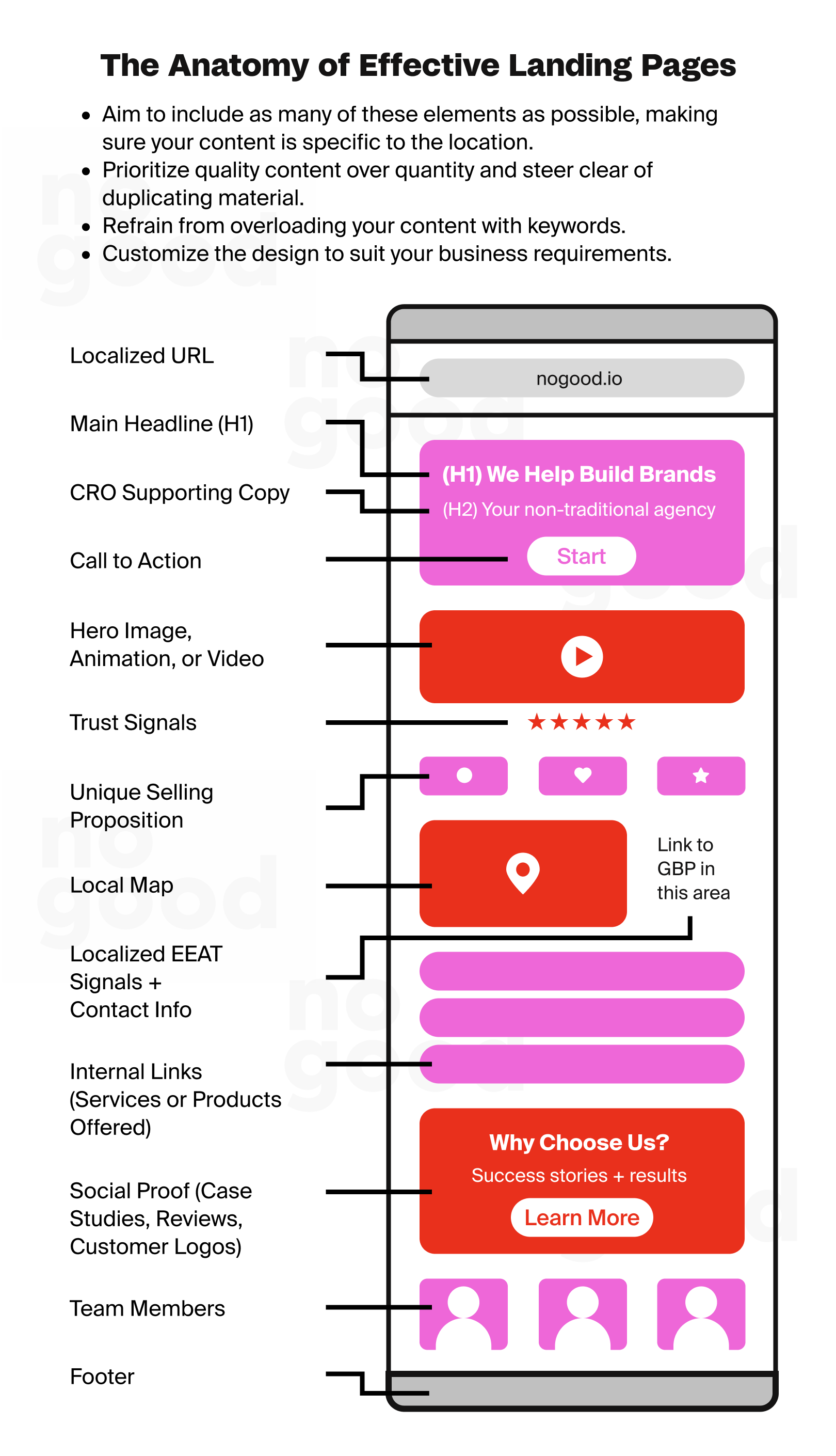
Best Practices for Optimizing Location Landing Pages
1. Localized URLs
One of the fundamental practices in optimizing location landing pages is using localized URLs. Incorporating local keywords into your URLs is a crucial ranking factor that enhances the visibility of location pages in search results. It’s essential to include both your service and location in the URL to align with the target keywords for the page.
There are various approaches to structuring localized URLs.
For instance, a URL like www.example.com/legal-services-new-york places the location immediately after the domain, indicating a single level down from the home page. However, employing this structure for all pages can lead to a flat website hierarchy, posing user navigation challenges and organizational difficulties for businesses.
To address this, you can adopt a parent-child page structure.

If your business operates nationally, across multiple cities, or as a franchise, consider making locations on the parent pages, such as:
- www.example.com/location/service
Conversely, if your business operates primarily at a local level or within a specific area, make services the parent pages, like:
- www.example.com/service/location
The choice of URL structure should align with your business’s scalability requirements and long-term organizational needs. Selecting the appropriate structure ensures that your website remains navigable for users and facilitates efficient indexing by search engine crawlers.
For more information regarding following Google’s guidelines on creating SEO-friendly URLs, check out our complete guide.
2. Localized H1 and Meta Title
Incorporating your service and location into the H1 heading and meta title can significantly boost search rankings, providing clear signals to Google about the page’s content. This practice also enhances accessibility and user experience by ensuring all visitors understand the page’s relevance to their search query.
However, there’s often a delicate balance between optimizing for SEO and crafting compelling copy.
The optimal approach involves leading with the targeted keyword and following it with a unique selling proposition that sets your business apart from competitors.
For example:
- “NYC Luxury Hair Salon | #1 in New York for Style with Sophistication”
- “Queens Gourmet Pizza Delivery | 24/7 Delivery”
- “Brooklyn Fitness Training Studio | No Hidden Costs”
- “Staten Island Photography Services | $60 Fixed Fee Per Hour”
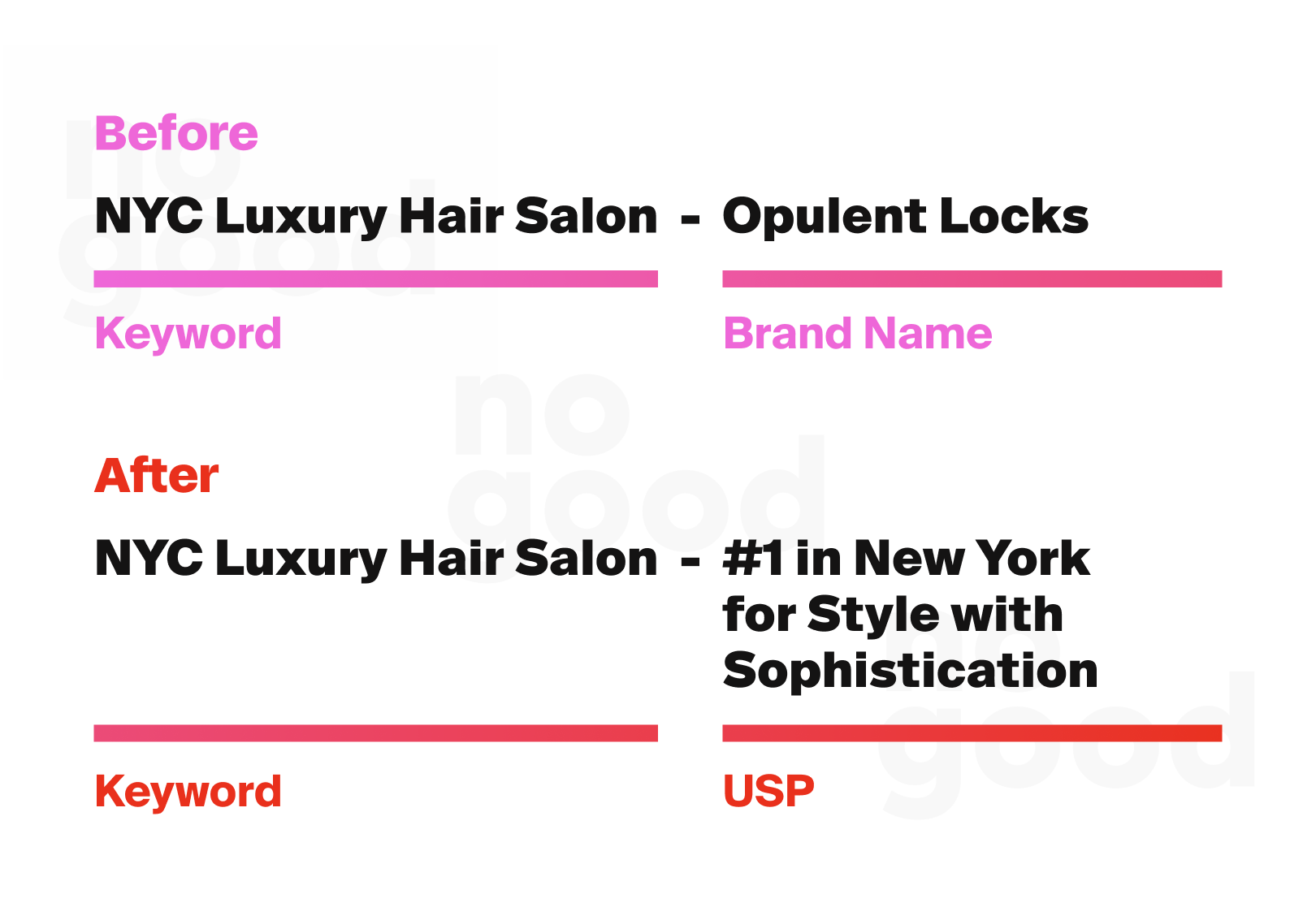
3. Conversion Rate (CRO) Supporting Copy
When it comes to website design, the homepage often steals the spotlight, but your location landing pages usually serve as the initial touchpoint for visitors. These pages are critical in shaping the user experience and driving conversions.
Upon landing on a location page, visitors immediately encounter the “above-the-fold” section—the portion visible without scrolling. This space presents a prime opportunity for conversion.
Since users often reach location pages directly from search results, optimizing the above-the-fold section is crucial to retaining their attention and encouraging conversion.
To enhance the conversion potential of your location pages, consider the following:
- Highlight your unique selling points prominently.
- Showcase aggregated reviews from platforms like Clutch.
- Address the searcher’s intent effectively, especially if they want to take offline action.
- Indicate your physical presence in the area.
- Provide clear calls to action supported by compelling conversion-focused copy.
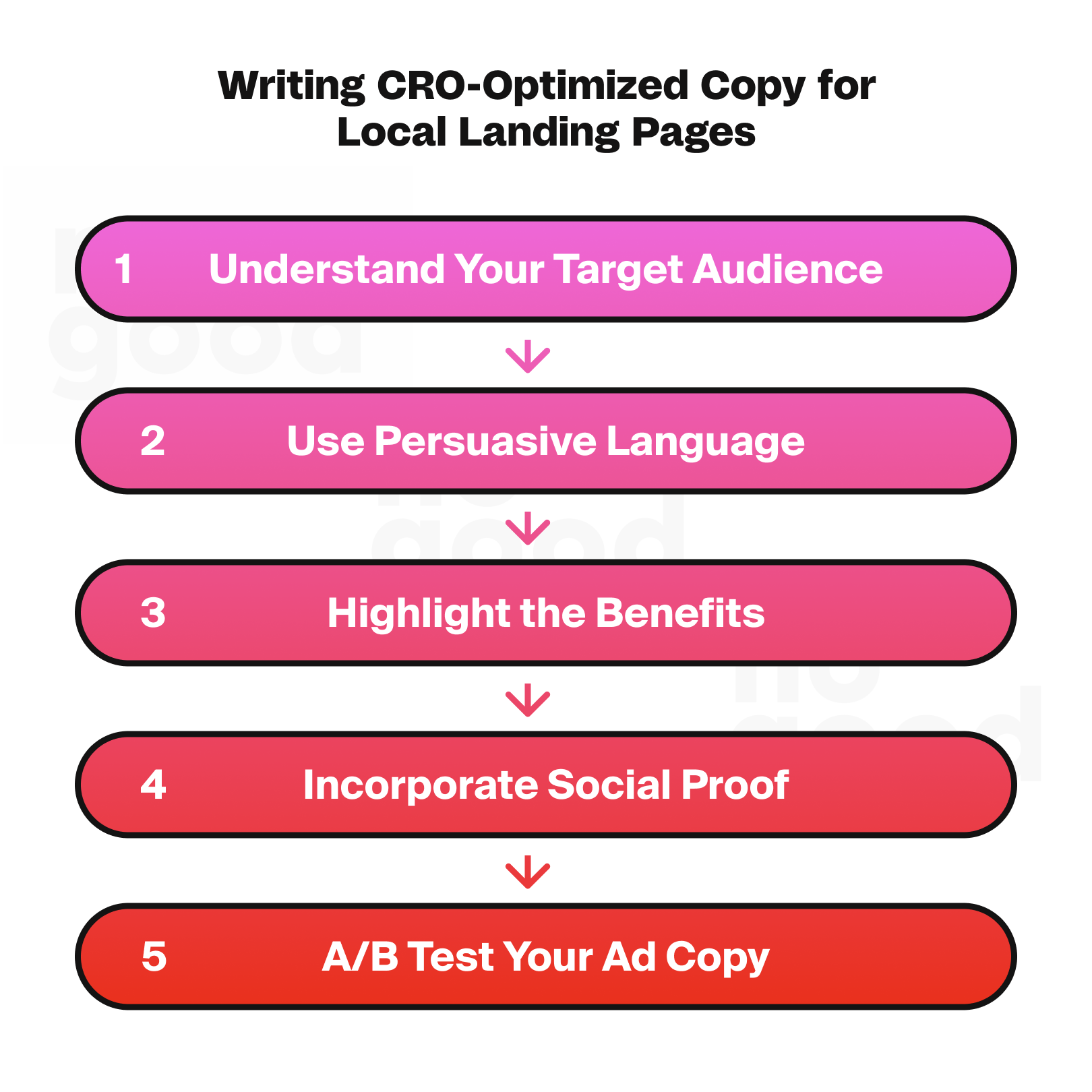
4. Incorporate Your Address and Embed Google Maps
If your business has a physical presence in the city, including your address and phone number on the landing page is essential. Additionally, embedding a Google Map can significantly enhance user experience by providing easy access to driving directions to your location.
Properly embedding Google Maps allows the map to display your brand and Google Business Profile reviews. This feature benefits both businesses with physical locations and service area businesses.
For service area businesses, embedding a Google Map is still valuable. Simply search for your Google Business Profile on Google Maps, click Share, then Embed a map, and copy the HTML code to paste onto your webpage. This ensures that visitors can easily locate and engage with your business.
5. Localized EEAT Signals + Contact Info
Localized EEAT signals, encompassing Expertise, Authoritativeness, and Trustworthiness, are pivotal for enhancing the credibility and visibility of local landing pages. These signals tell visitors and search engines that your business is reputable and dependable within its specific location or service area.
To optimize for EEAT signals and improve Search Engine Optimization, consider the following strategies:
- Expertise: Demonstrate your expertise in serving the local community by providing valuable, informative content tailored to local interests and needs.
- Authoritativeness: Showcase your authority within your industry or niche within the local market through authoritative content, industry certifications, awards, and partnerships with local organizations.
- Trustworthiness: Build trust with visitors by featuring customer testimonials, reviews, case studies, and endorsements from reputable local sources.
- Localized content: Ensure your content reflects the local context, including references to local landmarks, events, and community news.
- Local keywords: Incorporate relevant local keywords naturally throughout your content, including in headings, meta titles, and descriptions.
- Structured data markup: Use structured data markup to highlight your business’s location, contact information, and reviews, making it easier for search engines to understand and display this information.
- Google My Business optimization: Optimize your Google My Business listing with accurate business information, high-quality images, and regular updates.
- Consistent NAP information: Ensure consistency in your business’s Name, Address, and Phone Number (NAP) across all online platforms, including your website, directories, and social media profiles.
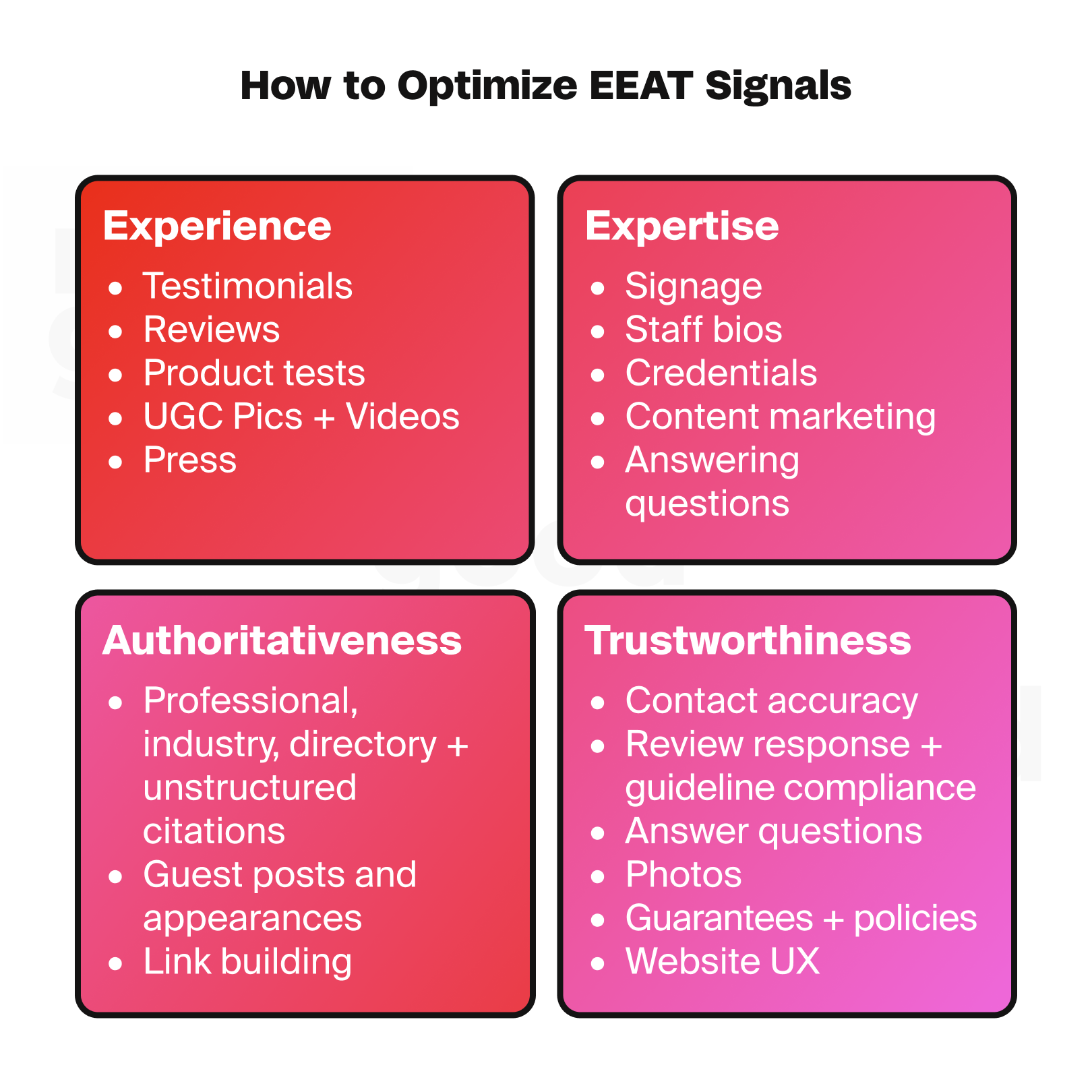
6. Add Unique & Relevant Images
Real photos carry more persuasive power than stock images. To bolster the credibility of your local landing pages, consider incorporating the following types of images:
- External shots of the location: Capture images of your premises from the outside, ideally with your logo prominently displayed. This is particularly beneficial for businesses with physical storefronts.
- Internal photographs of the reception area: Showcase your reception area and friendly staff to create a welcoming atmosphere for potential customers.
- Photos of each team member: Introduce your team members with individual photos to establish familiarity and trust. Show them in action or through professional headshots, depending on your business type.
- Close-ups related to the service: Provide close-up images illustrating your team’s expertise and the services they offer. Ensure branding is visible in the frame.
- Videos or virtual 360° tours: Offer immersive experiences through videos or virtual tours, allowing visitors to engage with your services dynamically. These can showcase your team’s capabilities and attention to detail.
Pro tip: Remember to apply alt text to all images on your local landing pages to enhance accessibility and aid search engines in understanding the content. Optimized alt text should accurately describe the image and may include relevant keywords to improve SEO performance.
7. Local Optimization for Mobile Users
With 57% of users stating they won’t recommend a business with a poorly designed mobile site, optimizing your local landing pages for mobile devices is essential. Google’s “mobile-first” index may already prioritize the mobile version of your site for search indexing.
Your landing pages should be responsive and load quickly on mobile devices to ensure a positive user experience. Test your pages on iOS and Android phones and make necessary adjustments.
Focus on:
- Large, easily readable text
- Neat formatting of page content within the phone screen
- Navigation tools tailored to the needs of mobile users
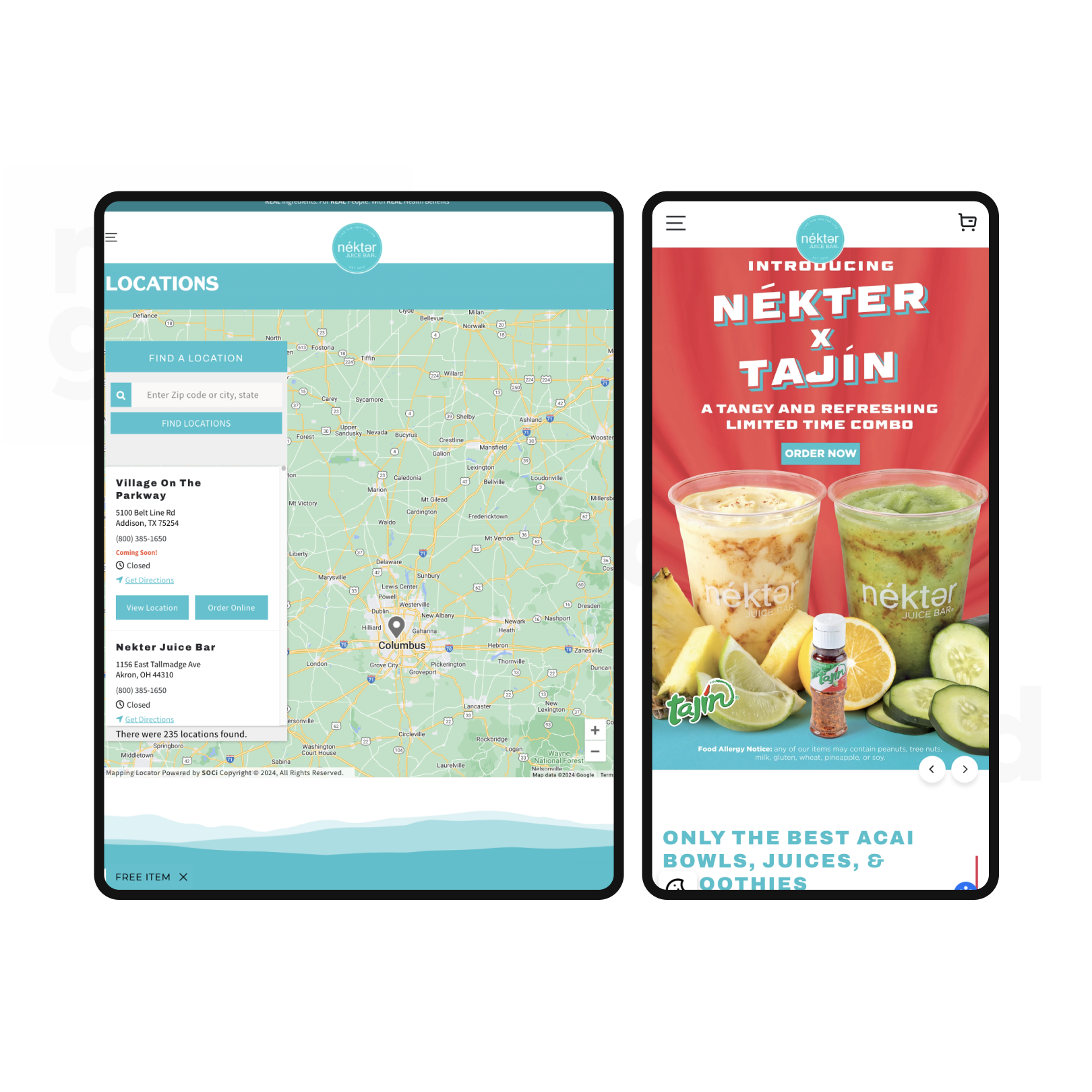
8. Adding Internal Links
Incorporating internal links or mentions to the services offered in each area serves multiple purposes:
- Enhance local optimization by targeting “service + location” keywords relevant to users’ searches.
- Provide visitors with a clear understanding of the services available at each location.
- Customize information, discounts, or offers specific to the local market, addressing their preferences and priorities.
From a design perspective, consider implementing an internal link component directing visitors to dedicated service pages tailored for each location. This approach ensures seamless navigation and facilitates access to detailed information about the services offered in their area.
Key Takeaways
- Prioritize local optimization: Incorporate relevant keywords and localized content to optimize your location landing pages for local SEO strategy, enhancing visibility and attracting local organic traffic.
- Enhance user experience: Focus on providing a seamless user experience by including clear calls-to-action, valuable content, and easy navigation tailored to the needs of your local audience.
- Utilize unique and relevant images: Real photos are more persuasive than stock images. Showcase your premises, team members, and services through unique and relevant images to bolster credibility and engagement.
- Mobile optimization: With many users accessing websites via mobile devices, ensure your location landing pages are responsive, load quickly, and offer a seamless experience on mobile platforms.
- Incorporate internal links: Enhance local optimization and user engagement by incorporating internal links to relevant services and offerings on each location landing page, facilitating navigation and providing comprehensive information to visitors.
- Embed Google Maps and contact information: Make it easy for visitors to find and contact your business by including your address and phone number and embedding Google Maps on your location landing pages.
- Focus on EEAT signals: Establish expertise, authoritativeness, and trustworthiness through localized content, customer testimonials, and industry certifications, reinforcing your business’s credibility within the local community.
By implementing these key practices, businesses can effectively optimize their location landing pages to drive local engagement, enhance visibility, and, ultimately, attract more customers.




